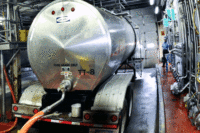Personnel training is one of the cornerstones of the Food Safety Modernization Act (FSMA). Under the Preventive Controls rules, employee training is now mandatory for both human food and animal food manufacturers. The rules require that these manufacturers conduct food safety and hygiene training for all of their employees.
A proper food safety plan
First and foremost, processors must have a Preventive Controls Qualified Individual who has received training under a standardized curriculum and must develop a Food Safety Plan (FSP). So how and where does hygienic design factor into the FSP?
The FSP must include a hazard analysis of all reasonably foreseeable food safety hazards. Such hazards requiring a preventive control must be controlled to prevent or minimize the likelihood of foodborne illness or injury, and this control must be documented. The preventive controls may expand beyond critical control points by identifying and implementing non-process related controls.
Hygienic design begins with the entire plant design. Be sure the actual structure has been designed with effective cleaning in mind.
Can the materials be cleaned with common cleaning chemicals? Looking at the layout, is there adequate space around the equipment to allow for inspection and cleaning? Are the floors sloped toward the drains, and equipment not placed in improper locations (e.g., too near to the drains)? Consider the need to replace older equipment to eliminate harborage points for bacteria. Keep a master sanitation schedule for the facility.
Preventive maintenance
The root cause of many foodborne outbreaks is often failure to maintain equipment under sanitary conditions. A master list of all equipment requiring maintenance must be maintained, including the maintenance schedule, responsibility and procedures.
The maintenance schedule will differ for most pieces of equipment. Many processors rely on a “risk assessment” for each piece of equipment to help determine the type and the frequency of periodic maintenance.
The schedule may call for replacing gaskets or other components every month. Be sure the operator or mechanic is properly trained so a small mistake does not lead to a big problem. And be sure to use replacement parts that were designed/manufactured to meet the intended use and method of cleaning. Suppliers of authorized 3-A equipment will provide instructions with the equipment and the type of cleaning for the equipment.
Training employees
Employee training is a large concern of food processors when it comes to inspections of FSMA compliance. Employee “visual inspections” represent the front line in determining sanitation effectiveness, though sanitation programs must rely on far more sophisticated measures for detecting pathogens and biofilms. Prevention of allergen cross-contact also ranks very high on the list for monitoring and validation. Hygienically designed and constructed equipment is a critical tool in developing and implementing preventive controls. Specifically:
- Materials of construction, whether metals or non-metals, must be inert, non-toxic, non-corrosive, non-contaminating and impervious to moisture.
- Surface finishes must be durable, free of cracks and crevices, and smooth to a maximum measure of 32 microinch Ra (roughness average) for a product contact surface.
- Joints of various types must be cleanable, crevice-free and bacteria-tight.
- Drainability — all surfaces must be free draining or drainable and properly pitched or sloped to prevent any liquid pooling.
- All construction elements must be bacteria-tight and accessible for cleaning, sanitizing and inspection.
Every component of the FSP should include proper documentation, including the preventive maintenance (PM) program. PM procedures (e.g., maintenance, lubrication, tool reconciliation, temporary/emergency repairs, spare parts inventory, training, audits of work quality) should become elements of an effective training program. The job does not end when such a large monitoring system is set up; many would say that getting all employees to follow those procedures accurately is the biggest challenge.


